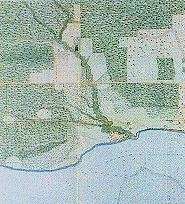Garrison Creek (Ontario)
| Garrison Creek | |
| River | |
 Lower course of Garrison Creek, circa 1818. | |
| Country | Canada |
|---|---|
| State | Ontario |
| City | Toronto |
| Source | Humewood Reach |
| - location | Dufferin Street and St. Clair Avenue West, Toronto, Ontario, Canada |
| Mouth | Toronto Bay |
| - location | Old Fort York, Toronto, Ontario, Canada |
| Length | 7.7 km (5 mi) |
Garrison Creek was a short stream about 7.7 kilometres (4.8 mi) long that flowed southeast into the west side of Toronto Harbour in Ontario, Canada.[1] It has been largely covered over and filled in, but geographical traces of the creek can still be found. The natural amphitheatre known as Christie Pits is one such remnant; the off-leash dog "bowl" of Trinity Bellwoods Park is another. The name "Garrison Creek" was used because Fort York was built near the creek mouth. Volunteers lead popular tours of the course of the old watershed.
History
Garrison Creek was one of a number of small natural watercourses on the site of the current city of Toronto.[1] Starting in the 1880s, the stream was diverted into underground sewers under city streets and the original course was filled in with soil. By 1920, the stream was entirely diverted into the sewer system. There are many artifacts of the Creek's existence, including buried bridges along Harbord Street and Crawford Street south of Dundas Street.[2]

In 2013 particularly strong rainstorms caused the storm sewers that replaced Garrison Creek to flood, at Christie Pits, Trinity Bellwoods Park, and a railway underpass at King Street and Atlantic Avenue.[3] Both Christie Pits and Trinity Bellwoods Park are over the original Garrison Creek Ravine, while the King and Atlantic intersection is over the course of Asylum Stream, a tributary.
Course
The stream had two sources, one north of St. Clair Avenue, near Humewood Public School, and the other northwest of the present-day Dufferin Street and St. Clair Avenue intersection.[1] The main course travels due south to south of King Street, where it turned to the southeast and emptied into Toronto Bay at the present-day intersection of Bathurst Street and Lake Shore Boulevard.
Tributaries along the creek included:[1]
- Springmount Stream
- London Stream
- Dewson Stream
- Asylum Stream
- Stafford Stream
- Denison Creek (which had its own tributaries):
- Brock Stream
- Havelock Stream
- Moutray Stream
See also
References
- 1 2 3 4 "Garrison Creek". Lost river walks. Archived from the original on February 28, 2011.
- ↑ Plummer, Kevin. "Buried Under Bellwoods". Torontoist. Gothamist. Retrieved June 25, 2011.
- ↑ Todd Harrison (July 9, 2013). "Toronto Flood 2013: The revenge of Garrison Creek". Spacings magazine. Archived from the original on September 14, 2013. Retrieved April 3, 2014.
Buried since the early 1900s, Garrison Creek now flows through a series of storm sewers from north of Davenport Road down to Lake Ontario. Christie Pits and Trinity Bellwoods are along the route of the creek proper, while the corner of King and Atlantic (pictured above) is near an adjoining buried waterway called Asylum Stream.